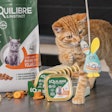Compound annual growth of 11.8%. Projected growth of 33%. Increases of 48%, 104%, 177%.
These are gaudy numbers from any point of view. And they apply to a booming new market for petfood and other pet products: Central and Eastern Europe.
At the first International Pet Conference, held in Frankfurt, Germany, this past November, experts from Euromonitor International, Dähne Verlag (the conference organizer), Information Resources Inc. and various pet retailers cited these and similar statistics to describe the current and estimated growth of the pet market in countries such as Poland, Slovakia, Romania and Bulgaria.
(The figures, respectively, represent growth of the pet market in Eastern Europe since 2001, projected growth for that market by 2011, growth of dog and cat food sales in the Czech Republic from 2000 to 2005 and growth of dog food, sales at 104% and volume at 177%, in Romanian grocery outlets from September 2005 to September 2006.)
Lots of pets
According to Ralf Majer-Abele, managing editor of Pet in Europe magazine and the conference chair, Eastern European countries comprise four of the top five European countries in dogs and cats per capita. And those pet owners are learning more about proper pet nutrition and enjoying more discretionary income to provide it.
He also explained that in these countries, the majority of dog and cat meals are still prepared by owners from table scraps and other "people food." But manufactured petfood is steadily growing in sales, especially in urban areas and for inexpensively priced products, often produced by private label manufacturers. In capital cities, premium brands are gaining traction, benefiting from owners' increasing awareness of pet health issues and inclination to treat their pets as family members, like the humanization of pets so prevalent in developed markets.
This all adds up to continued high growth potential for petfood in the region, according to Majer-Abele, as people there continue to gravitate toward Western living standards and become more interested in product quality. One caveat is the continued risk for political instability of some of the region's countries.
Politics and petfood
Indeed, some of the most interesting sessions at the conference were by executives from Eastern European retailers and pet suppliers describing the many political changes in their countries over the past two decades and how those have affected the pet market. Tamas Gorcs, owner of Ti&To Co., a retailer in Bratislavia, Slovakia, led attendees through a brief history of pet shops in the country. His reasons for predicting continued growth in Eastern Europe, increased popularity of dry petfood, rising sales through pet superstores and a shift in marketing toward education, echoed those of other conference speakers.
Gorcs was followed by Irina Papazova, CEO of Felina Bulgarien, a distributor for Vitakraft products based in Plovdiv, Bulgaria. Her moving description of the impact of recent political upheaval in her country on pets and their owners drew a standing ovation. She ended on a positive note, citing statistics such as 19% growth in 2006 sales of dry cat food through one Bulgarian grocery chain.
The conference also covered the potential for the pet market in China. According to Gorcs, developing markets overall will comprise 20% of the global pet market by 2015. He cited total growth of the Eastern European market from 1996 to 2005 as 320%, followed only by Asia (excluding Japan) at 220%. Now how's that for gaudy?
Corrections
In the November 2006 issue of Petfood Industry , the source for the chart on p. 22 was Euromonitor International. On p. 33, the correct E-mail address for Ron Fuller is [email protected].













